Solid entry, but uncharacteristic issues hold it back
Leaving the Old World behind and moving the action to 18th-century America,Assassin’s Creed III’s setting is a clear indication of the forward progress the series has decided to take after two years of retreading old ground. The relative side stories of Brotherhood and Revelations were great games in their own right but ACIII is the first full sequel since the series became an annual fixture. It’s big, ambitious and final, concluding the overarching tale of Desmond Miles while telling the story of a completely new character in an unexplored place in time. This momentous scale brings with it its own problems, but perhaps the greatest issue facing ACIII is a sense of burnout after four straight years locked inside the Animus.
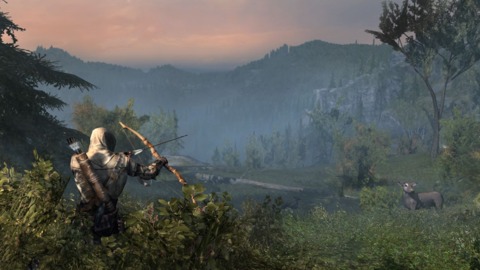
If you’ve been disillusioned with the slow pace of Desmond’s sci-fi meta-story you’ll be pleased to see it come to a head here. After discovering that the world is on the brink of apocalypse, Desmond and his merry Mystery Gang head off in search of a way to stop it, once again entering the Animus and inhabiting the life of one of Desmond’s ancient ancestors.
Between all of the 18th-century action, ACIII occasionally cuts back to Desmond, going so far as to send him on a few missions himself, allowing us to finally sample the Assassin move set he picked up from previous protagonist Ezio Auditore. These sections help flesh out an underutilised aspect of the series but the promise Desmond’s present day tale has always carried is never fulfilled. Apart from one early skyscraper sequence his missions are linear and uninspired, and the narrative quickly reaches an abrupt and disappointing conclusion that seems more concerned with dumping a 20-minute credit sequence on your head than allowing for any thoughtful reflection on what just transpired. After five games worth of build up it’s sad to see it crawl to a disheartening whimper.
Fortunately the main brunt of the narrative rests on the broad shoulders of Connor Kenway (or Ratohnhaké:ton, if you want to wrap your tongue around that). Half-Native American, half-British, he lacks the charm and instant likeability of Ezio but he’s much more conflicted and sees a greater emphasis placed on his character development. Like ACII, we’re treated to a childhood and adolescence that shapes Connor’s motivations and who he is, gradually building him up before he’s recruited by the Creed.
Revenge fuels his quest but there’s also a great sense of idealism and an inherent naivety that comes with that, which is often challenged by men on both sides of the Revolutionary war, pulling Connor and his beliefs in multiple directions. He often feels like a blank slate lacking in personality and you’ll long for the days of Ezio’s charisma and quick wit, but Connor’s interactions with his enigmatic adversaries make for compelling viewing as his loyalties are constantly contested and personal stakes are introduced.
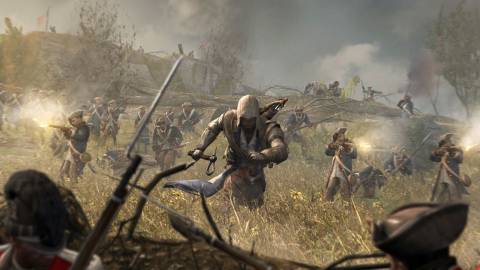
ACIII does a fantastic job of blurring the line between good and evil, right and wrong. This isn’t as blunt as British Loyalists vs. American Revolutionaries, or even Templars vs. Assassins; it’s never so black and white, shrouding both sides in grey. Most of The Founding Fathers weren’t saints, they were slave owners and drunkards who committed heinous acts during The Seven Year War, and ACIII treats them as such. Its villains are set in stone but even their words begin to convince you that what they’re doing is right. It paints them as real human characters with their own established and justified motivations and viewpoints, making them something more than just the historical figures they are – transcending the history books.
The backdrop of the Revolutionary War offers many opportunities to explore the era’s most significant moments - and you witness and are involved in many, such as the Boston Tea Party and the Battle of Bunker Hill - but Connor’s story is only tangentially related to the war. He’s not a hero who always saves the day; he fails and falters, but keeps trying. All of the political intrigue is pushed to the background in favour of telling a human tale and developing Connor as a character. It’s an admirable approach that pays off, even if Connor never quite fills out his protagonist’s boots.
Where he excels is in the treetops, although you’ll have to wait a long time before you can get there. ACIII’s tutorial lasts a staggering eight hours; an incredibly long introduction that slowly rolls out every new system and mechanic while familiarising you with the way an Assassin’s Creed game plays. It often feels like overload but there’s also a lot of non-tutorialized gameplay within that timeframe, and a large focus on the narrative: establishing characters and the world. Patience is definitely required but if you can muster it then this kind of world building is discernible, and its big twist is especially enjoyable.
Once you do eventually don the infamous white robes the world of ACIIIimmediately opens up. There’s always something new to do and something else to distract you on your way to doing it. From hunting wildlife and skinning it to sell, to sitting at a campsite listening to tales of mystical creatures, collecting feathers and opening chests, assassinating targets, crafting materials and sending them on convoys to be sold, scaling the highest structures, saving prisoners from a firing squad, capturing a Templar fortress, playing board games in a pub and searching the eastern seaboard for a long lost treasure, the list surprisingly goes on and on.
There’s a breadth of content spread across the cities of Boston and New York and the forested wilderness of the Frontier, constantly pulling you from one direction to the next in search of hidden collectibles and expansive side quests.
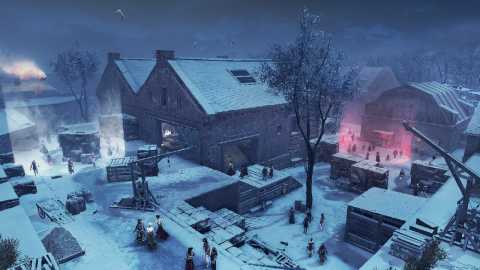
Take your Homestead, for example; a vast piece of land that houses Connor’s home and the game’s economy. Gone are the stream of purchasable shops, replaced by NPCs and their unique set of skills. Optional side quests allow you to recruit people to settle on your Homestead, contributing to the community as lumberjacks, blacksmiths and so on. Gather the right ingredients and they’ll be able to craft items you can’t buy in general stores like specific weapons and larger pouch upgrades, as well as items like clothes and food that generate income.
Watching your Homestead continue to grow as more and more people settle is a joy, but the crafting only moves to convolute your acquisition of money, having you shift through counterintuitive menus more often than you care to. The majority of side quests unfortunately feel the same way. Superfluous additions that offer no tangible rewards and little reason to see them through apart from a sense of completion.
The search for a long lost treasure provides some of the game’s most impressive platforming moments, but for the most part heading to a waypoint and pressing B is all that’s required to complete a number of quests. They lack the imagination of something like Leonardo Da Vinci’s inventions quest line, or the expansive platforming beneath the city of Rome, disappointing with their linearity and repetition.
And yet it’s incredibly easy to find yourself immersed in this world, searching every nook and cranny for one last almanac page, no matter how incidental the reward. This is due in no small part to improvements made to the series’ base gameplay mechanics and its rendition of 18th-century America. The cities of Boston and New York are meticulously designed, from the crumbling and ash-covered remnants of New York’s great fire through to a bustling market street watched keenly by an ominous group of Red Coats, and a harbour housing gargantuan ships and small fishing boats. It feels authentic and alive, all the while offering a verticality that allows you to seamlessly bound to its highest peak in a matter of moments.
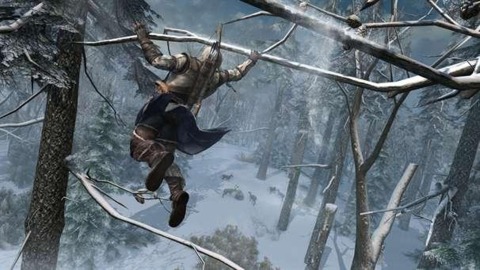
Platforming has been refined, smartly preventing you from unintentionally leaping to your death by freeing the jump button for use only when you want to use it. You can climb and leap without fear, gleaning joy from its fluidity and ease of use. And this is only expanded once you enter the Frontier and its natural beauty. As a Native, Connor learned at an early age how to effortlessly move through the treetops. Before long you’ll instantly recognise its climbing points, able to distinguish a route through the trees and glide along it in an instant. The treetops may offer an intricately designed path but it feels completely natural, complimented by excellent animation and visuals that capture the superb art design.
Though with this added scale and visual fidelity comes a host of technical issues. The frame rate is inconsistent and often stuttering, especially in cities. The draw distance is also rather poor, coating the landscape in a layer of distant fog, and pop-in appears constantly. Although neither of these technical problems compares to the amount of bugs and glitches likely to appear in your playthrough.
From visual oddities like NPCs regularly filtering in and out of existence to more substantial concerns like the scripting continuously failing, forcing restarts. You’ll help a group of Patriots and have them thank you before they suddenly attack for no reason. You can swing your sword all you want but your hits won’t register, forcing you to run away or randomly vibrate on the spot as the game struggles to deal with what’s transpiring.
Then you’ll encounter assassination targets that can’t be attacked, or a town crier that can’t be bribed when your notoriety is high. Maybe you’ll head to a map marker for a mission only to find nothing there. Sometimes that same map marker will completely disappear, or you’ll be unable to hire assassin recruits for the entire game. It’s a disappointing and frustrating laundry list of glitches that places a dampener on proceedings. For one of the biggest releases of the year, it’s inexcusable.
And other issues persist within the gameplay and mission design. Combat remains as simplistic as ever. A few quick sword strikes and a counter attack is enough to defeat most enemies; other, tougher enemies require an extra button press to break their guard before attacking, but the variety presented by smoke bombs and firearms is an option of choice rather than a requisite. Nonetheless, combat remains enjoyable despite its lack of challenge, the free-flowing nature, brutality of each hit and variation of animations dependent on each weapon is wholly satisfying. It’s when attempting to be stealthy that ACIII falters.
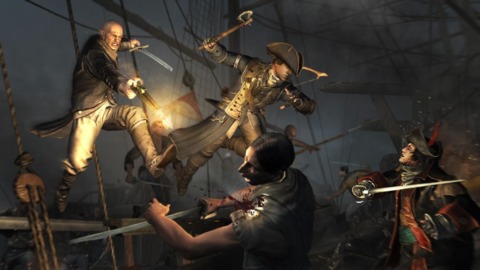
Brush and long grass present opportunities for Connor to hide, while haystacks and verticality give him an extra helping hand. But immediate fail states leave little room to be anything but immaculate; a difficult proposition considering the lack of effective stealth mechanics. Not only can your enemies see for miles but there is no sort of crouch or stealth ‘mode’, leaving you to stand in broad daylight, quite unlike any trained assassin. It feels clumsy and you’re never quite sure how it works. Sometimes if you try to hide in a pile of bushes after being seen Connor will just stand up, while other times he will actually hide. It’s inconsistent and inconsistency is the bane of any stealth game; the linearity of these sections and immediate fail states halts emergent improvisation.
And then you come to the chase sequences and the accomplishments of the platforming are foregone and replaced by frustration. The myriad of contextual actions leaves you blending into crowds when you don’t want to, accidentally climbing up buildings or hugging the corner of a wall. Guards will knock you down and won’t let you back up, and then you find the mission design has you running laps unless you manage to find a specific shortcut to close the gap. You and your target running along the same route, past the same people and the same guards; the Benny Hill theme running in your head as it’s the only thing that makes sense.
But now you find yourself on the open sea and all those grievances seem inconsequential. You’re captaining a mighty vessel, sails bustling in the wind and cannonballs roaring through the sky, culminating in a glorious explosion and amplified by a riveting score. A thunderous storm approaches, creating monstrous waves that threaten to capsize these ancient ships. You line up your shots between the waves, letting loose when the opportunity arises. You change course, travelling with the momentum of the wind beneath your sails, powering full speed ahead to ram your target, crippling their hull and leaving them defenceless.
Naval combat is a fantastic addition to the series. There’s unbounded satisfaction to be had destroying other ships and gliding across the water; the mechanics work exceptionally well. Each turn of the wheel has real weight behind it, the close proximity of the camera inciting immersion while the weather and water effects consistently amaze.
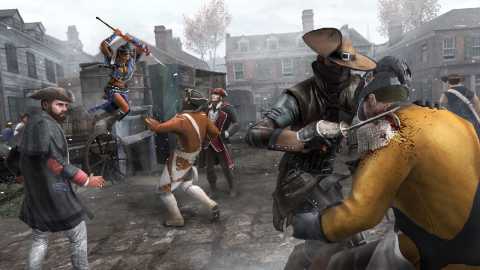
The series’ unique brand of multiplayer also makes a triumphant return. Contextualised as an Abstergo project to be sold as the next big gaming system, there’s an admirable attention to narrative that results in enjoyably hokey live-action advertisements unlocking as you level up. Its tense assassin vs. assassin gameplay is as accomplished as ever as you attempt to hunt down a specific target (or targets) without being killed yourself. There’s immense satisfaction to be gleaned from outwitting your foes, blending into a crowd and stunning your hunter at the last possible moment, or leaping from a rooftop to achieve a high scoring kill on the unsuspecting target below.
Refinements have also been made to the way it presents information to you. Much like Mark of the Ninja’s approach to stealth and the way information is visually displayed within the environment, ACIII’s multiplayer uses audio cues. If you have line-of-sight on your target a heartbeat can be heard, increasing in volume as you move closer. If your hunter has a bead on you you’ll be able to hear whispers, letting you know to be extra cautious and prepare to get that all-important stun attack if you can master its strict timing.
There’s also a new co-op mode called Wolf Pack, where four players can team up against AI targets with a countdown clock limiting your progression to the next target. You’ll want to move fast to limit the countdown, while also working together to earn bonuses like multi-kill that require you and your team-mates to perform near-simultaneous assassinations. It’s completely engaging, though, like most co-op modes, it works best with people you know.
When its glitches reveal themselves and poor design designs and mechanics arise, it’s easy to be disappointed with Assassin’s Creed III. But the risks it takes with its storytelling, the focus on characterisation and the way it expands and refines its gameplay fundamentals and how it approaches an open-world, strikes a unique balance between chagrin and gratifying elements that almost make you forget its indiscretions. That it fails to address issues that have plagued the series since its inception is regrettable, but it would be foolhardy to expect another leap as substantial as the one taken between the original Assassin’s Creed and its first sequel. Nonetheless, despite staving off series burnout, Assassin’s Creed III still doesn’t quite do enough. What it does do well it does with confidence, but uncharacteristic issues prevent it from being top of the class.
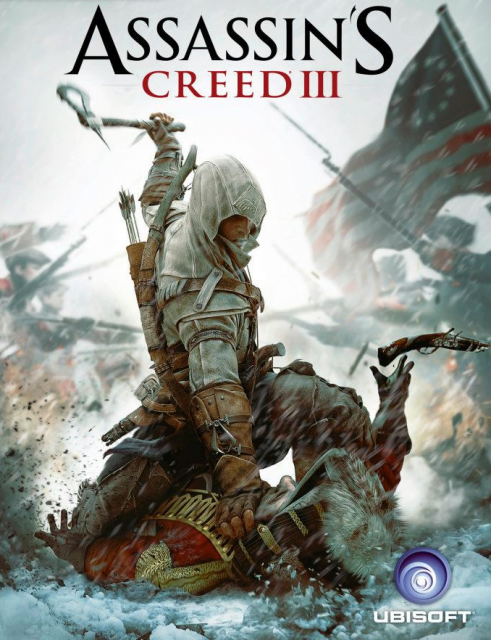
0 Comments